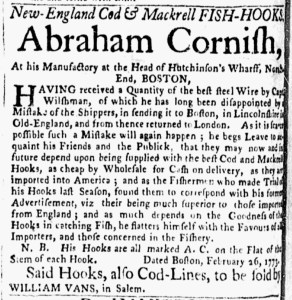What was advertised in a colonial American newspaper 250 years ago today?

“His present determination is to go home to London in the Fall; he is therefore determined to sell off the whole of his Goods … at the very lowest Rate.”
In the summer of 1773, Samuel Flagg took to the pages of the Essex Gazette to promote the “general Assortment of English and India GOODS” that he recently received via “the last Shops from London and Bristol.” He directed prospective customers interested in “Hosery of all sorts,” “men’s and boys felt Hats of all sizes,” “a good assortment of Paper Hangings,” “an assortment of Ship-Chandlery,” and “almost every other Article usually enquired for” to visit his shop “two Doors below the Town-House” in Salem.
To entice consumers, Flagg declared that he parted with his imported goods “as low as they can be bought at any Store on the Continent, without any Exception.” It was a bold claim. The merchant not only compared his prices to prices set by competitors in Salem and nearby Boston but also to prices found anywhere in Britain’s mainland colonies. To back up this claim, Flagg explained that “his present Determination is to go home to London in the Fall.” Accordingly, “he is therefore determined to sell off the whole of his Goods … at the very lowest Rate, by Wholesale and Retail.” Flagg sought to demonstrate that he did not make idle promises about his prices. Instead, his plans to return to London motivated him to liquidate his merchandise over the course of the next several months.
Although he did not deploy the same phrases that marketers would come to use in the twentieth and twenty-first centuries, Flagg experimented with a strategy eventually known as a liquidation sale, selling his inventory at a significant discount in order to generate cash in advance of closing his business. At the same time, he encouraged former customers and other associates indebted to him to settle accounts “for the above Reason,” departing for London, so he would be ready to travel in the fall.
Other advertisers offered their wares “very cheap for Cash or short Credit” or “at the very lowest Rate,” but did not provide assurances or explanations. Nathaniel Sparhawk declared that he sold his imported goods “as cheap for Cash or short Credit as at any Store in this Town (without Exception),” but did not offer any comments about why prospective customers should trust that proclamation. In the June 15 edition of the Essex Gazette, only James Grant took an approach that resembled Flagg’s strategy, declaring that he “will sell for the sterling Cost and Charges,— as he intends going into some other Business.” In colonial Salem, some entrepreneurs experimented with marketing strategies, such as liquidation sales, that became much more common more than a century later.









